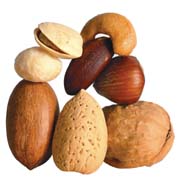
Indeed, in recent years, consumers have learned a great deal about both. They know how to discriminate between simple and complex carbohydrates, i.e., net carbs vs. dietary fiber. And, in less than a year, revised Nutrition Facts labels will include a separate listing for trans fatty acids. Plus, the recent qualified health claim associating omega-3 fatty acid consumption with reducing the risk of coronary heart disease reinforces the fact that some fats are not only not bad for you, they are actually beneficial. Sound nutty? Well, yes, it is.
Here's when it gets even nuttier. Tree nuts, such as almonds, cashews, hazelnuts, macadamias, pecans, pistachios and walnuts, as well as peanuts, are naturally low in net-carbs and are cholesterol free. They are packed full of protein, fiber and phytochemicals, and are a great source of vitamins such as folic acid, niacin, and vitamins E and B6, and minerals like magnesium, copper, zinc, selenium, phosphorus and potassium. Furthermore, the majority of the fat in these nuts is unsaturated, or "good" fat, i.e., mono- and polyunsaturated fats. In fact, certain varieties, particularly walnuts, contain a noteworthy amount of omega-3s.
The nut industry was the first to introduce a qualified health claim about a year ago. Packages of approved nuts can bear the claim: Scientific evidence suggests but does not prove that eating 1.5oz per day of most nuts as part of a diet low in saturated fat and cholesterol may reduce the risk of heart disease.
The International Tree Nut Council Nutrition Research & Education Foundation is taking steps to educate consumers on the benefits of consuming nuts. One message explains that the key to including nuts in the diet without adding extra fat and calories is portion control. As little as one handful-or one ounce-of nuts per day can provide nutritional benefits. The Foundation offers consumers serving suggestions that include dairy products, such as sprinkle chopped nuts on yogurt or in cream cheese spreads for bagels. Add nuts to a cheese and cracker platter, or sprinkle them on top of ice cream, frozen yogurt and parfaits.
The dairy industry can help consumers get their daily dose of nuts by formulating with them, and flagging their inclusion on product labels. Ben & Jerry's never shied away from nuts, often times including more than two varieties in abundance in one pint. For example, there's been Nutcracker Suite, This is Nuts™ and Totally Nuts.
Besides being a perfect inclusion for ice cream, nuts also readily blend into cream cheese and cheese spreads, as well as rolled onto the infamous cheese ball. Is there any opportunity here to revisit the side-by-side or domed yogurt and cottage cheese cups? Yogurt made with real fruit (particularly berries, for all those proanthocyanins), and an accompanying packet of chopped pecans should be very attractive to consumers taking a proactive approach to health and wellness.
Here's the last bit of nuttiness for you. Others are taking note of the healthful halo surrounding foods such as nuts. Bissinger's Handcrafted Chocolatier, a long-established, upscale chocolate company in St. Louis, Mo., recently rolled out Spa Chocolate. The elegant packaging in which the pricey chocolates come says that the candies contain ingredients "linked to improved cardiovascular health, lowered risk for certain types of cancer, a reduction in weight and a slowing of the aging process." The ingredients spotlighted include the most obvious, chocolate, which happens to be dark, fruits and, you guessed it, nuts.
Get nutty in 2005 and mix some crunch and flavor into your dairy formulations!